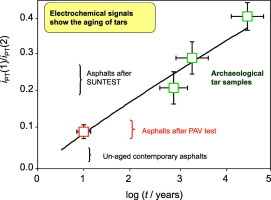Electrochemistry Communications ( IF 5.4 ) Pub Date : 2017-12-20 , DOI: 10.1016/j.elecom.2017.12.020 Antonio Doménech-Carbó , Géssica Domingos da Silveira , María Ángeles Medina-Alcaide , Adoración Martínez Carmona , David López-Serrano , Trinidad Pasíes-Oviedo , Víctor M. Algarra-Pardo , Leandro Machado de Carvalho , Noemí Montoya

|
The voltammetry of immobilized microparticles (VIMP) was used to characterize organosulfur components from ovens found at the Spanish archaeological sites of Cueva de Nerja (ca. 35,000 cal BC), la Illeta dels Banyets (4th century BCE) and Gestalgar (12th–13th CE), and asphalt probes subjected to PAV and SUNTEST aging protocols. The voltammetric responses of the archaeological samples and the asphalt probes after photodegradation were quite similar, indicating the presence of polythiophene components which could act as age/degradation markers.
中文翻译:

聚噻吩是沥青和考古焦油沥青老化的标志。使用固态电化学进行表征
固定微粒的伏安法(VIMP)用于表征烤箱中的有机硫成分,这些烤箱位于西班牙内瓦哈(Cueva de Nerja)(约35,000 cal BC),La Illeta dels Banyets(约公元前4世纪)和Gestalgar(约公元前12至13世纪)的西班牙考古现场),以及经过PAV和SUNTEST老化协议的沥青探针。考古样品和沥青探针在光降解后的伏安响应非常相似,这表明存在聚噻吩成分,可以用作老化/降解标记。



























 京公网安备 11010802027423号
京公网安备 11010802027423号